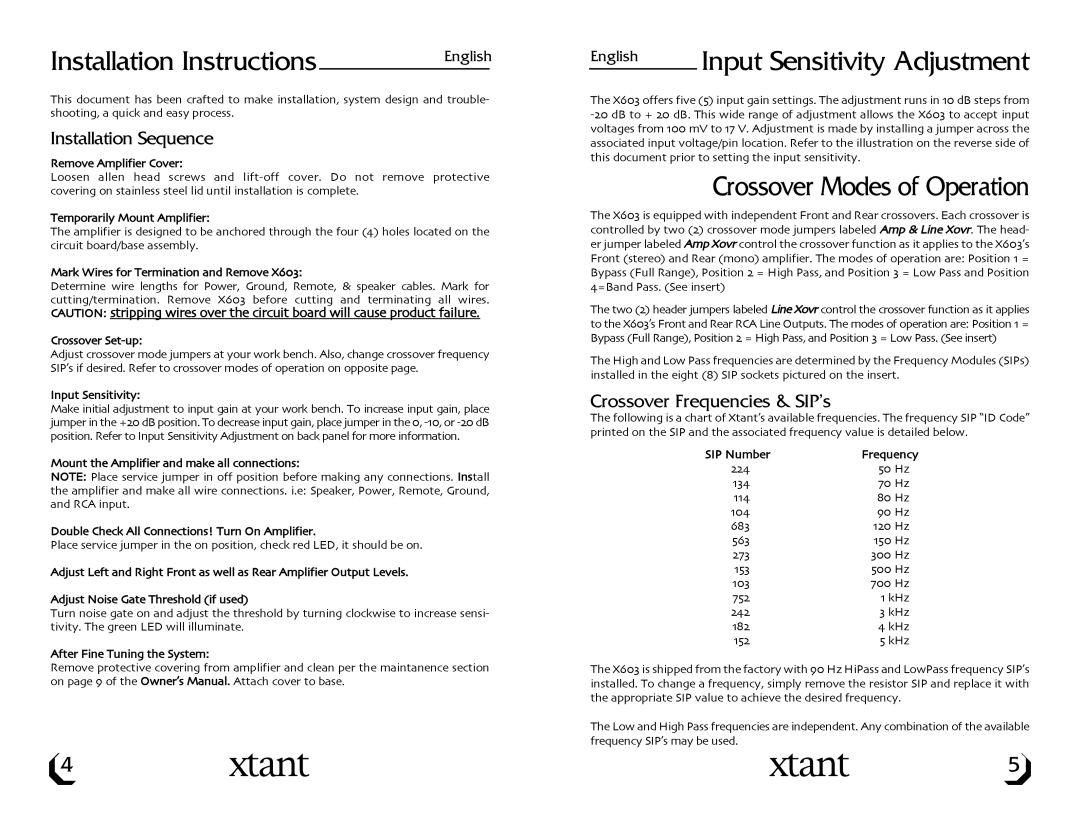
Installation Instructions | English | |
|
| |
This document has been crafted to make installation, system design and trouble+ shooting, a quick and easy process*
Installation Sequence
Remove Amplifier Cover:
Loosen allen head screws and lift+off cover* Do not remove protective covering on stainless steel lid until installation is complete*
Temporarily Mount Amplifier:
The amplifier is designed to be anchored through the four (") holes located on the circuit board/base assembly*
Mark Wires for Termination and Remove X%(':
Determine wire lengths for Power, Ground, Remote, & speaker cables* Mark for cutting/termination* Remove X%(' before cutting and terminating all wires*
CAUTION: stripping wires over the circuit board will cause product failure*
Crossover Set+up:
Adjust crossover mode jumpers at your work bench* Also, change crossover frequency SIP’s if desired* Refer to crossover modes of operation on opposite page*
Input Sensitivity:
Make initial adjustment to input gain at your work bench* To increase input gain, place jumper in the .!( dB position* To decrease input gain, place jumper in the (, +$(, or +!( dB position* Refer to Input Sensitivity Adjustment on back panel for more information*
Mount the Amplifier and make all connections:
NOTE: Place service jumper in off position before making any connections* Install
the amplifier and make all wire connections* i*e: Speaker, Power, Remote, Ground, and RCA input*
Double Check All Connections! Turn On Amplifier*
Place service jumper in the on position, check red LED, it should be on*
Adjust Left and Right Front as well as Rear Amplifier Output Levels*
Adjust Noise Gate Threshold (if used)
Turn noise gate on and adjust the threshold by turning clockwise to increase sensi+ tivity* The green LED will illuminate*
After Fine Tuning the System:
Remove protective covering from amplifier and clean per the maintanence section on page & of the Owner’s Manual* Attach cover to base*
4
English | Input Sensitivity Adjustment |
|
The X%(' offers five ()) input gain settings* The adjustment runs in $( dB steps from +!( dB to . !( dB* This wide range of adjustment allows the X%(' to accept input voltages from $(( mV to $# V* Adjustment is made by installing a jumper across the associated input voltage/pin location* Refer to the illustration on the reverse side of this document prior to setting the input sensitivity*
Crossover Modes of Operation
The X%(' is equipped with independent Front and Rear crossovers* Each crossover is controlled by two (!) crossover mode jumpers labeled Amp & Line Xovr* The head+ er jumper labeled Amp Xovr control the crossover function as it applies to the X%('’s Front (stereo) and Rear (mono) amplifier* The modes of operation are: Position $ / Bypass (Full Range), Position ! / High Pass, and Position ' / Low Pass and Position "/Band Pass* (See insert)
The two (!) header jumpers labeled Line Xovr control the crossover function as it applies to the X%('’s Front and Rear RCA Line Outputs* The modes of operation are: Position $ / Bypass (Full Range), Position ! / High Pass, and Position ' / Low Pass* (See insert)
The High and Low Pass frequencies are determined by the Frequency Modules (SIPs) installed in the eight
Crossover Frequencies & SIP’s
The following is a chart of Xtant’s available frequencies* The frequency SIP “ID Code” printed on the SIP and the associated frequency value is detailed below*
SIP Number | Frequency |
!!" | )( Hz |
$'" | #( Hz |
$$" | -( Hz |
$(" | &( Hz |
$!( Hz | |
)%' | $)( Hz |
!#' | '(( Hz |
$)' | )(( Hz |
$(' | #(( Hz |
#)! | $ kHz |
!"! | ' kHz |
" kHz | |
$)! | ) kHz |
The X%(' is shipped from the factory with &( Hz HiPass and LowPass frequency SIP’s installed* To change a frequency, simply remove the resistor SIP and replace it with the appropriate SIP value to achieve the desired frequency*
The Low and High Pass frequencies are independent* Any combination of the available frequency SIP’s may be used*
5
